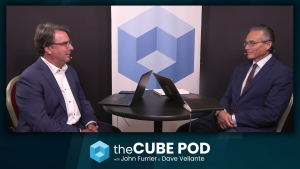Flash matures, becomes best storage option for many | #vmworld
![]() Flash is at it’s economic tipping point, said Violin Memory, Inc. CMO Eric Herzog. It’s reached the financial sweet spot that makes it the most viable option for many companies. Herzog sat down with theCUBE hosts Dave Vellante and John Furrier at VMware, Inc.’s annual VMworld conference to talk about the evolution of flash, the resiliency of the RAID stack, and the best data reduction services.
Flash is at it’s economic tipping point, said Violin Memory, Inc. CMO Eric Herzog. It’s reached the financial sweet spot that makes it the most viable option for many companies. Herzog sat down with theCUBE hosts Dave Vellante and John Furrier at VMware, Inc.’s annual VMworld conference to talk about the evolution of flash, the resiliency of the RAID stack, and the best data reduction services.
Herzog believes that flash has reached it’s maturation phase, meaning that certain trends are starting to form when it comes to flash use cases. Some companies, like Herzog’s own Violin Memory, are focused on performance flash, while other want what Herzog described as “cheap ‘n deep flash –” storage that’s ideal for workloads that are capacity sensitive, not performance sensitive.
Latency is essential for performance
At Violin Memory, performance is a package that includes “both good iOPs and really strong latency,” which Herzog considers especially key for companies at global enterprise level. Latency, he said, is a cornerstone of storage, because many workloads, including “an Oracle workload, a SAP workload, a SQL workload,” are highly latency-sensitive.
Violin “can guarantee under half a millisecond latency,” Herzog boasted, placing the company in among the elite of low-latency providers. When customers perform host-based aggregation in production, Herzog said that Violin arrays are able to deliver “two million sustained iOPs regardless of workload across all those petabytes and .15 milliseconds of latency.”
Herzog explained that for “database workloads, for virtualized workloads,” flash just works better. He cited the example of a customer who, when they converted to flash, were able to drastically increase capacity on the same piece of hardware by switching to flash, enabling them to run 50 virtual machines where they had once been able to run fourteen.
Consistency, Herzog added, is also a big part of what Violin Memory offers to customers: “We guarantee consistent IOPS (Input/Output Operations Per Second), and consistent latency whether the array is empty, half-full, or all the way full.”
Performance and resiliency from the RAID stack
In response to Vellante’s question about how the tech world should think about the stack, Herzog replied that for Violin Memory, “RAID stack was always crucial. RAID is not just about performance…it’s number one function when RAID came out…was resiliency.” Performance comes in as a close secondary benefit, though, as it allows companies to aggregate performance across pieces of media.
Herzog called out that one of the benefits some vendors offer in the flash space, including Violin, is their history with flash configuration. Their RAID stack, he said, is in an eight year time frame — in comparison to other start ups which have a “Two-year old RAID stack.” The benefit of an eight-year old RAID stack, Herzog explained, is that it boasts more resiliency and test time. As a testament to the resiliency of Violin’s stack, Herzog noted proudly that “50 of the global fortune 500 use Violin.”
Data reduction: Is Oracle the best option?
Switching gears, Vellante asked Herzog how practitioners and tech companies should think about data reduction, especially now that Violin is moving into that field. “The bottom line,” Herzog replied, “is that data dedupe will help you on two primary workloads: virtual desktop and virtual server. Beyond that, it doesn’t help.” Compression, meanwhile, helps in database workloads, but some types of data are just not compressible.
Practitioners need to segment their workloads, Herzog said. The number of terabytes in the arrays that Violin offers, which can scale up to 280 terabyte capacity, Herzog says, make Violin an ideal technology to run a variety of workloads, including Oracle.
While Violin Memory offers compression and dedupe, some customers still opt to use Oracle to compress their data. Whether customers decide to use Violin Memory’s data reduction or Oracle’s, Herzog said, is a matter of price. Oracle is a powerful tool, but a costly one. Violin Memory’s compression is reasonable, “but a lot less expensive.” It comes down to customer’s financial analysis.
Herzog’s switch from EMC to Violin
Herzog left his role as a senior executive at EMC Corp. to be a part of Violin Memory. Even after Violin’s initial stumble with its IPO, Herzog was so impressed with Violin’s big-name customers that he decided to get onboard.
For Herzog, achieving the right balance of seasoned management and great tech guys can really drive a company to success. He believes Violin has found this equilibrium: “We’ve got the right team in place now to take the technology where it needs to go to deliver business value to the shareholders and stockholders.”
photo credit: fab34 via photopin cc
A message from John Furrier, co-founder of SiliconANGLE:
Your vote of support is important to us and it helps us keep the content FREE.
One click below supports our mission to provide free, deep, and relevant content.
Join our community on YouTube
Join the community that includes more than 15,000 #CubeAlumni experts, including Amazon.com CEO Andy Jassy, Dell Technologies founder and CEO Michael Dell, Intel CEO Pat Gelsinger, and many more luminaries and experts.
THANK YOU









